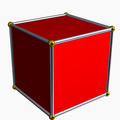Cuboid
Cuboid
The Cuboid is one of the seven tarsal bones located in the foot. It is situated on the lateral (outer) side of the foot, in front of the calcaneus, behind the fourth and fifth metatarsal bones, and underneath the navicular bone.
Structure[edit]
The cuboid bone is cube-shaped and presents six surfaces. It is the fifth largest bone in the foot and plays a crucial role in stabilizing the lateral column of the foot.
Surfaces[edit]
- Dorsal surface: This surface is rough for the attachment of ligaments.
- Plantar surface: This surface contains a groove for the tendon of the peroneus longus.
- Medial surface: This surface is broad and triangular, and articulates with the third cuneiform, and sometimes with the navicular.
- Lateral surface: This surface is smaller and of a quadrilateral form.
- Proximal surface: This surface articulates with the calcaneus.
- Distal surface: This surface articulates with the fourth and fifth metatarsal bones.
Function[edit]
The cuboid bone helps to stabilize the outer foot and allows for the foot to bear weight. It also plays a role in the movement of the foot, particularly in walking and running.
Clinical significance[edit]
Injuries to the cuboid bone, such as fractures or dislocations, can cause significant pain and disability. These injuries are often caused by trauma to the foot, such as a fall or a direct blow. Treatment typically involves immobilization of the foot and may require surgery in severe cases.
See also[edit]
References[edit]
<references />
Ad. Transform your life with W8MD's Budget GLP-1 injections from $75


W8MD offers a medical weight loss program to lose weight in Philadelphia. Our physician-supervised medical weight loss provides:
- Weight loss injections in NYC (generic and brand names):
- Zepbound / Mounjaro, Wegovy / Ozempic, Saxenda
- Most insurances accepted or discounted self-pay rates. We will obtain insurance prior authorizations if needed.
- Generic GLP1 weight loss injections from $75 for the starting dose.
- Also offer prescription weight loss medications including Phentermine, Qsymia, Diethylpropion, Contrave etc.
NYC weight loss doctor appointmentsNYC weight loss doctor appointments
Start your NYC weight loss journey today at our NYC medical weight loss and Philadelphia medical weight loss clinics.
- Call 718-946-5500 to lose weight in NYC or for medical weight loss in Philadelphia 215-676-2334.
- Tags:NYC medical weight loss, Philadelphia lose weight Zepbound NYC, Budget GLP1 weight loss injections, Wegovy Philadelphia, Wegovy NYC, Philadelphia medical weight loss, Brookly weight loss and Wegovy NYC
|
WikiMD's Wellness Encyclopedia |
| Let Food Be Thy Medicine Medicine Thy Food - Hippocrates |
Medical Disclaimer: WikiMD is not a substitute for professional medical advice. The information on WikiMD is provided as an information resource only, may be incorrect, outdated or misleading, and is not to be used or relied on for any diagnostic or treatment purposes. Please consult your health care provider before making any healthcare decisions or for guidance about a specific medical condition. WikiMD expressly disclaims responsibility, and shall have no liability, for any damages, loss, injury, or liability whatsoever suffered as a result of your reliance on the information contained in this site. By visiting this site you agree to the foregoing terms and conditions, which may from time to time be changed or supplemented by WikiMD. If you do not agree to the foregoing terms and conditions, you should not enter or use this site. See full disclaimer.
Credits:Most images are courtesy of Wikimedia commons, and templates, categories Wikipedia, licensed under CC BY SA or similar.
Translate this page: - East Asian
中文,
日本,
한국어,
South Asian
हिन्दी,
தமிழ்,
తెలుగు,
Urdu,
ಕನ್ನಡ,
Southeast Asian
Indonesian,
Vietnamese,
Thai,
မြန်မာဘာသာ,
বাংলা
European
español,
Deutsch,
français,
Greek,
português do Brasil,
polski,
română,
русский,
Nederlands,
norsk,
svenska,
suomi,
Italian
Middle Eastern & African
عربى,
Turkish,
Persian,
Hebrew,
Afrikaans,
isiZulu,
Kiswahili,
Other
Bulgarian,
Hungarian,
Czech,
Swedish,
മലയാളം,
मराठी,
ਪੰਜਾਬੀ,
ગુજરાતી,
Portuguese,
Ukrainian











